It was Fort Worth’s first freeway, established thirty-five years before the town saw its first automobile. It was the Interstate 35 of its day, moving mustangs and mavericks from south to north through Texas, Oklahoma, and Kansas almost a century before the Ford Motor Company rolled out Mustangs and Mavericks. And decades before the stockyards and packing plants were built, it was the reason why Fort Worth was called “Cowtown.”
It was the Chisholm Trail, and during its short life it moved more than five million cattle and one million mustangs in the greatest migration of livestock in world history; it helped revive Fort Worth’s economy during the years between the Civil War and the delayed arrival of the railroad; and it was named for a man who, although he was many things, was not a cattleman.
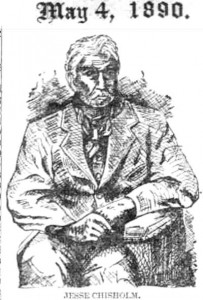 Jesse Chisholm (not to be confused with cattle baron John Chisum) was born in Tennessee in 1805 to a Scots immigrant father and a Cherokee mother. As a child Chisholm lived with the Cherokee people in Arkansas. In the late 1820s he moved to the Cherokee Nation in eastern Indian Territory (Oklahoma) and became a trader, establishing trading posts and delivering buffalo hides and other goods to Native Americans and whites by wagon in Oklahoma and Kansas and Texas. Chisholm’s knowledge and background made him much in demand on the frontier. Because his travels in three states as a trader gave him extensive knowledge of geography, he was in demand as a guide. And because Chisholm spoke several Native American dialects and was a man of both the red world and the white world, he was in demand as an interpreter and liaison at treaty councils between whites and Native Americans in Texas, Oklahoma, and Kansas. For example, in 1844 Chisholm played a key role in the peace efforts of Republic of Texas President Sam Houston at the Tehuacana Creek councils. And in 1846 Chisholm brought Comanches to a treaty council with whites at Comanche Peak (Glen Rose) and then served as interpreter for U.S. President James K. Polk when a delegation of the Comanche Peak council went to Washington.
Jesse Chisholm (not to be confused with cattle baron John Chisum) was born in Tennessee in 1805 to a Scots immigrant father and a Cherokee mother. As a child Chisholm lived with the Cherokee people in Arkansas. In the late 1820s he moved to the Cherokee Nation in eastern Indian Territory (Oklahoma) and became a trader, establishing trading posts and delivering buffalo hides and other goods to Native Americans and whites by wagon in Oklahoma and Kansas and Texas. Chisholm’s knowledge and background made him much in demand on the frontier. Because his travels in three states as a trader gave him extensive knowledge of geography, he was in demand as a guide. And because Chisholm spoke several Native American dialects and was a man of both the red world and the white world, he was in demand as an interpreter and liaison at treaty councils between whites and Native Americans in Texas, Oklahoma, and Kansas. For example, in 1844 Chisholm played a key role in the peace efforts of Republic of Texas President Sam Houston at the Tehuacana Creek councils. And in 1846 Chisholm brought Comanches to a treaty council with whites at Comanche Peak (Glen Rose) and then served as interpreter for U.S. President James K. Polk when a delegation of the Comanche Peak council went to Washington.
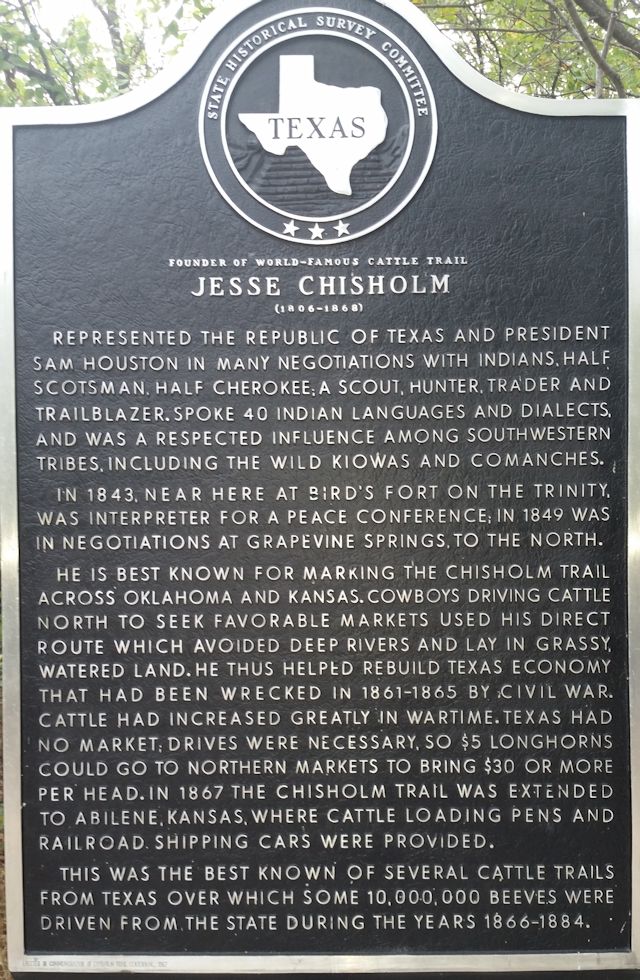 This marker in River Legacy Park, Arlington, says Chisholm served as interpreter at Bird’s Fort in 1843 and at Grapevine Springs (Grapevine) in 1849.
This marker in River Legacy Park, Arlington, says Chisholm served as interpreter at Bird’s Fort in 1843 and at Grapevine Springs (Grapevine) in 1849.
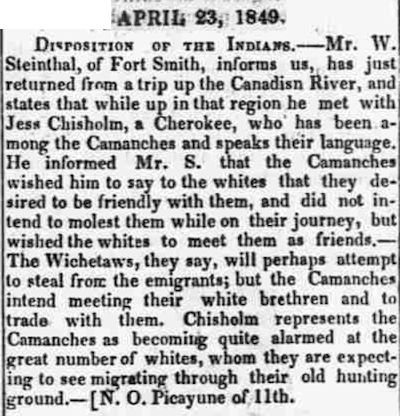 In 1849, just as Major Ripley Arnold and his men were establishing Fort Worth on the western frontier, a white traveler in Oklahoma encountered Jesse Chisholm, who told him that the Comanche “desired to be friendly” but were “quite alarmed by the great number of whites, whom they are expecting to see migrating through their old hunting ground.” (From the Democratic Banner of Missouri.)
In 1849, just as Major Ripley Arnold and his men were establishing Fort Worth on the western frontier, a white traveler in Oklahoma encountered Jesse Chisholm, who told him that the Comanche “desired to be friendly” but were “quite alarmed by the great number of whites, whom they are expecting to see migrating through their old hunting ground.” (From the Democratic Banner of Missouri.)
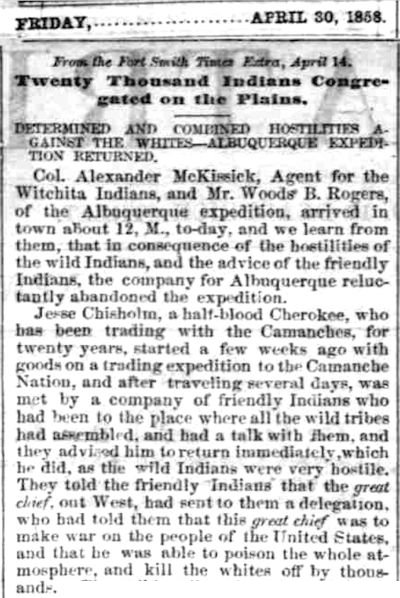 In 1858 Chisholm met “a company of friendly Indians” who told him that they had been warned that the “great chief” of a group of “wild Indians” was to “make war on the people of the United States” and “kill the whites off by thousands.” (From the Nashville Patriot.)
In 1858 Chisholm met “a company of friendly Indians” who told him that they had been warned that the “great chief” of a group of “wild Indians” was to “make war on the people of the United States” and “kill the whites off by thousands.” (From the Nashville Patriot.)
Then came the Civil War. Chisholm worked first for the Confederacy as a trader and then for the Union as a Native American interpreter.
In 1864 Chisholm expanded his trade route, hauling his goods back and forth between Wichita, Kansas on the Arkansas River and Council Grove (near today’s Oklahoma City) on the North Canadian River on a trail sections of which had been used earlier by Native Americans, soldiers, and buffalo. That year, as he traveled while trading, he marked his trade route of about 220 miles.
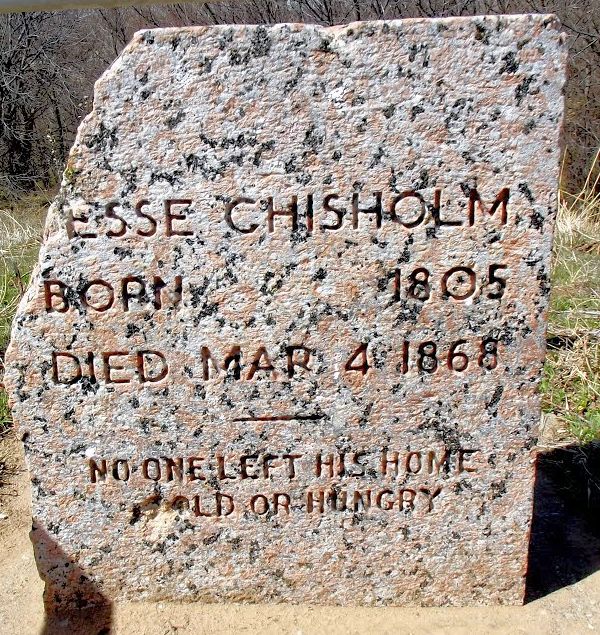 Jesse Chisholm died in 1868. His tombstone in Oklahoma reads, “No one left his home cold or hungry.”
Jesse Chisholm died in 1868. His tombstone in Oklahoma reads, “No one left his home cold or hungry.”
Now let’s back up one year.
After the Civil War the economy of Texas was depressed. Texas was home to millions of free-roaming longhorn cattle that had multiplied while grazing unattended during the war. In fact, longhorns were so plentiful that they didn’t have much value here. Ah, but elsewhere, in the Midwest and the East, longhorns could be much more valuable.
But how to get longhorns from Texas to markets in the Midwest and East? Remember that in the 1860s railroads were scarce in Texas. That meant cattle drives: herding the cattle to market on horseback.
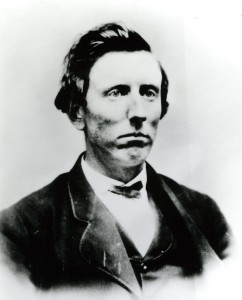
Enter Joseph Geiting McCoy (photo from Wikipedia). McCoy was an Illinois entrepreneur whose special interest was mules and cattle. He was aware of the dire situation in Texas. (In 1874 he would recall: “There dawned a time in Texas that a man’s poverty was estimated by the number of cattle he possessed.”) McCoy knew of the limited options for Texas cattlemen who wanted to get their cattle to market. He knew of the steamboats that hauled Texas cattle up the Mississippi River to markets from New Orleans. He knew of the cattle trails from Texas northward: Goodnight-Loving on the west and Shawnee on the east.
But Joseph McCoy had a better idea.
Because he also knew of Jesse Chisholm’s trading trail in Oklahoma and Kansas.
McCoy wrote of that trail: “It has more prairie, less timber, more small steams and fewer large ones, altogether better grass and fewer flies—no civilized Indian tax [a fee that Indians charged whites to cross Indian land] or wild Indian disturbances—than any other route yet driven over. It is also much shorter because [it is] direct from the Red River to Kansas.”
McCoy hired a surveyor to survey Jesse Chisholm’s trail and to build mounds of dirt to mark the trail.
In Kansas in 1867 the Union Pacific railroad had just laid track westward from Kansas City into Abilene, Kansas. McCoy, convinced that the railroad, after hauling freight in from the east, would rather haul loaded cars than empty cars on return trips east, persuaded Union Pacific to lay a siding at Abilene to load cattle onto cars. Then he bought 250 acres of land on which he built a stockyards, a stable, a hotel, and a bank.
There was just one problem: Kansas ranchers objected to Texas longhorns crossing their land en route because the cattle might carry ticks that spread Texas fever (also called “Spanish fever”), which could make a longhorn sick but could kill other breeds of cattle. Kansas and Missouri even enacted a quarantine against Texas cattle. Abilene lay within the Kansas quarantine zone. McCoy negotiated an agreement with Kansas ranchers, promising to pay them for any cattle killed by longhorn-borne disease, and convinced the governor of Kansas to allow Texas longhorns in the quarantine zone.
McCoy’s representatives then canvassed Texas, posting placards, going from ranch to ranch to spread the word: If Texas cattlemen would drive their longhorns to Abilene, McCoy would buy them at a good price.
And he did.
The first Texas herd to follow the Chisholm Trail from Texas to Abilene belonged to Colonel Oliver Wolcott Wheeler and his partners. When Wheeler’s cowboys reached the North Canadian River in Indian Territory they spotted the wagon tracks of Jesse Chisholm and followed them northward to Wichita, Kansas and then continued on to Abilene on a trail that McCoy’s men had marked as the final leg of the trail.
 Joseph McCoy shipped the first twenty carloads of Texas longhorns from Abilene to Chicago on September 5, 1867. This account by a writer of the New York Tribune describes the scene in Abilene. McCoy shipped thirty-five thousand head of cattle that year and double that amount the next year. Each year the number doubled until 1871, when more than a half-million head were shipped, and as many as five thousand cowboys were paid in a single day. Also that year McCoy was elected the first mayor of Abilene. Among his early acts of office was to appoint James Butler “Wild Bill” Hickok city marshal.
Joseph McCoy shipped the first twenty carloads of Texas longhorns from Abilene to Chicago on September 5, 1867. This account by a writer of the New York Tribune describes the scene in Abilene. McCoy shipped thirty-five thousand head of cattle that year and double that amount the next year. Each year the number doubled until 1871, when more than a half-million head were shipped, and as many as five thousand cowboys were paid in a single day. Also that year McCoy was elected the first mayor of Abilene. Among his early acts of office was to appoint James Butler “Wild Bill” Hickok city marshal.
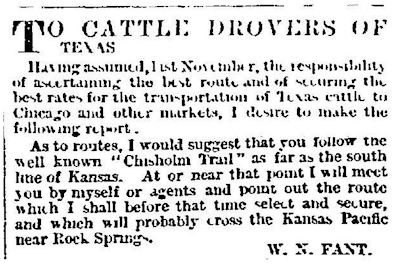 This clip from the Galveston Tri-Weekly News of March 30, 1870 is part of an open letter written by railroad agent W. N. Fant to Texas cattle drovers about how to ship their cattle by rail after the herds reached Kansas. Fant, later president of the Indianola, San Antonio and El Paso Railroad, lived in Goliad and surely was William Nevitt Fant (1822-1888), who was father of Chisholm Trail herder Dillard Rucker Fant (1841-1908), also of Goliad.
This clip from the Galveston Tri-Weekly News of March 30, 1870 is part of an open letter written by railroad agent W. N. Fant to Texas cattle drovers about how to ship their cattle by rail after the herds reached Kansas. Fant, later president of the Indianola, San Antonio and El Paso Railroad, lived in Goliad and surely was William Nevitt Fant (1822-1888), who was father of Chisholm Trail herder Dillard Rucker Fant (1841-1908), also of Goliad.
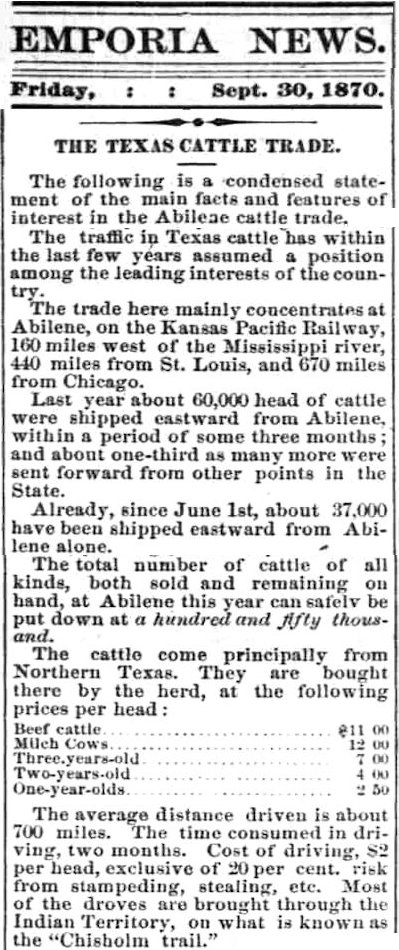 This clip from the Emporia (Kansas) News of September 30, 1870 provides some statistics for the Chisholm Trail traffic.
This clip from the Emporia (Kansas) News of September 30, 1870 provides some statistics for the Chisholm Trail traffic.
 From the Dallas Daily Herald of April 4, 1876.
From the Dallas Daily Herald of April 4, 1876.
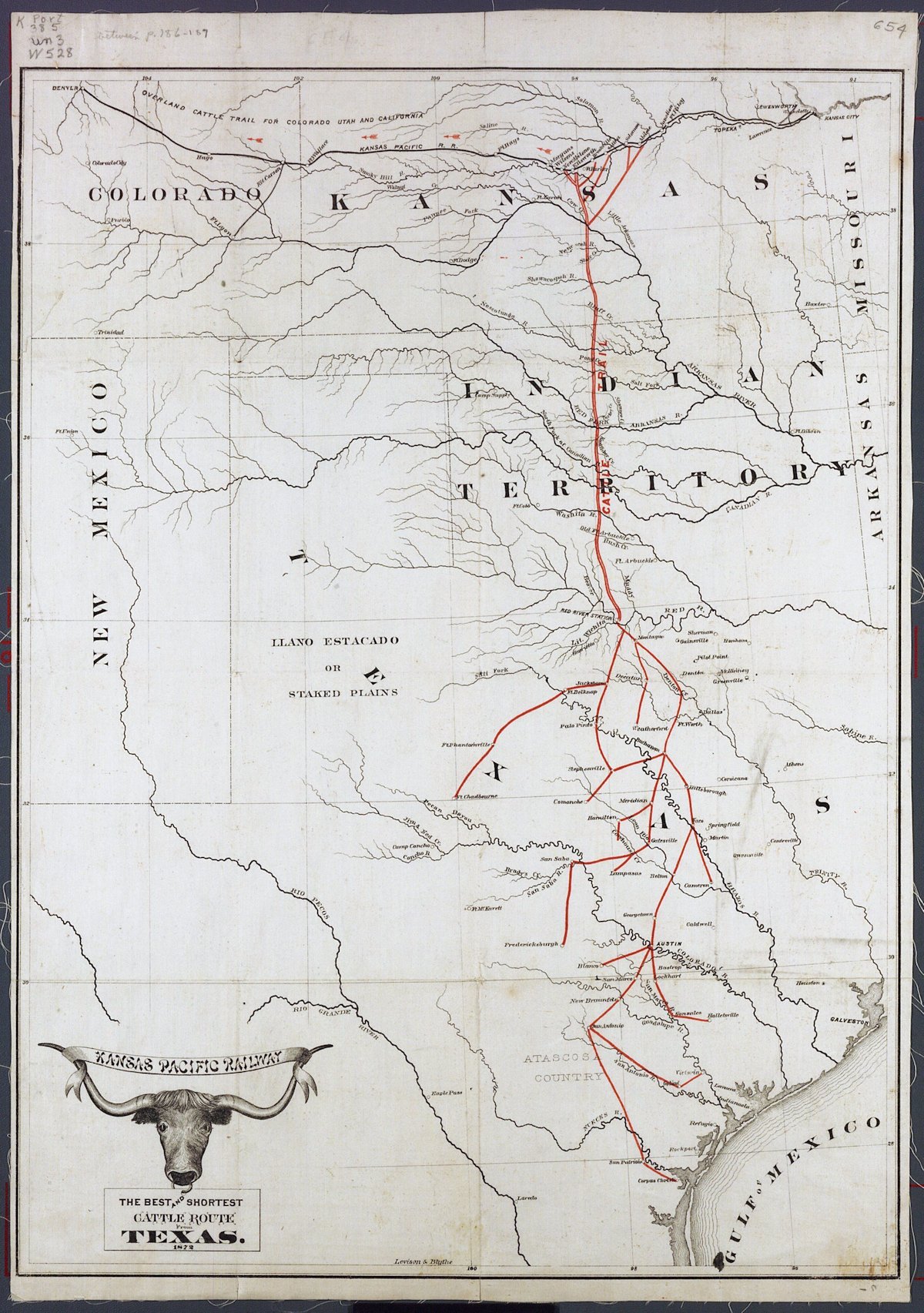 On this 1872 map the Chisholm Trail is the double line from the Red River to Abilene. In terms of miles, Jesse Chisholm’s trading trail constituted a modest part of the overall Chisholm Trail. And that trail really was more a network covering three states from south Texas to northern Kansas. Think of a tree. In Texas were small feeder trails that began in south Texas and merged with a large feeder trail by the time that large feeder trail reached Red River Station in Montague County. These were the roots of the tree. The Chisholm Trail from Red River Station north into Kansas was the trunk. And as the railroads progressed westward with time, a few feeder trails from the top of the trunk to railheads other than Abilene were the limbs. From south Texas to Abilene was more than eight hundred miles. (Map from Kansas Historical Society.)
On this 1872 map the Chisholm Trail is the double line from the Red River to Abilene. In terms of miles, Jesse Chisholm’s trading trail constituted a modest part of the overall Chisholm Trail. And that trail really was more a network covering three states from south Texas to northern Kansas. Think of a tree. In Texas were small feeder trails that began in south Texas and merged with a large feeder trail by the time that large feeder trail reached Red River Station in Montague County. These were the roots of the tree. The Chisholm Trail from Red River Station north into Kansas was the trunk. And as the railroads progressed westward with time, a few feeder trails from the top of the trunk to railheads other than Abilene were the limbs. From south Texas to Abilene was more than eight hundred miles. (Map from Kansas Historical Society.)
Technically the large feeder trail in Texas was known as the “McCoy Trail” (or “Eastern Trail”) after Joseph McCoy encouraged Texas ranchers to drive their herds north to Abilene via Jesse Chisholm’s trading trail. The McCoy Trail stretched from Brownsville north through the cattle empire of Richard King, then to Refugio, Goliad, Lockhart, Austin, Belton, Waco, Hillsboro, thundered smack dab through the middle of Fort Worth, skirted Decatur, and finally crossed the river into Indian Territory at Red River Station.
Imagine the reactions of the cowboys as they passed through those towns driving cattle north:
Brownsville: “Too much sun here. Get along, little dogie.”
Austin: “Too many politicians here. Get along, little dogie.”
Waco: “Too many preachers here. Get along, little dogie.”
Fort Worth: “Whoa! Boys, I just seen a female wink at me. And she don’t have four stomachs, four hooves, and a tail! We’re beddin’ down here for the night. Maybe two.”
And so was born Hell’s Half Acre from all that beef on the hoof and all that testosterone on the saddle.
After visiting Fort Worth in 1872, Colonel John Wien Forney of the Texas & Pacific railroad wrote: “During the last year, 500,000 head of cattle were driven through Fort Worth on their way to Kansas and Missouri, and as we left the town we met a single drove containing 1,250 head.”
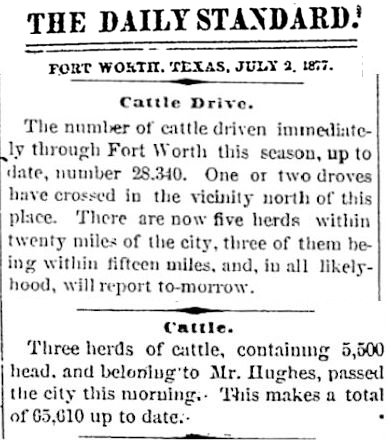
 In 1877 the Daily Fort Worth Standard kept track of the number of cattle being herded through town. In the bottom clip, Captain Mifflin Kenedy, for whom the south Texas county is named, and Captain Richard King of the King Ranch were partners.
In 1877 the Daily Fort Worth Standard kept track of the number of cattle being herded through town. In the bottom clip, Captain Mifflin Kenedy, for whom the south Texas county is named, and Captain Richard King of the King Ranch were partners.
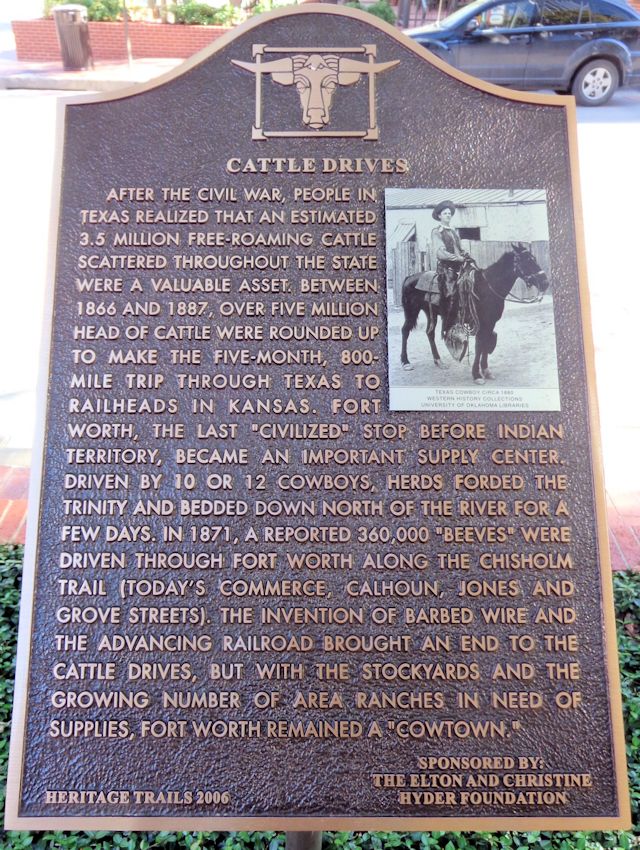 This marker downtown says cowboys moved their cattle through Fort Worth on the eastern edge of town in a three-block-wide corridor between Commerce and Grove streets. Commerce Street would become the Acre’s main drag, lined with saloons and “female boarding houses” (brothels).
This marker downtown says cowboys moved their cattle through Fort Worth on the eastern edge of town in a three-block-wide corridor between Commerce and Grove streets. Commerce Street would become the Acre’s main drag, lined with saloons and “female boarding houses” (brothels).
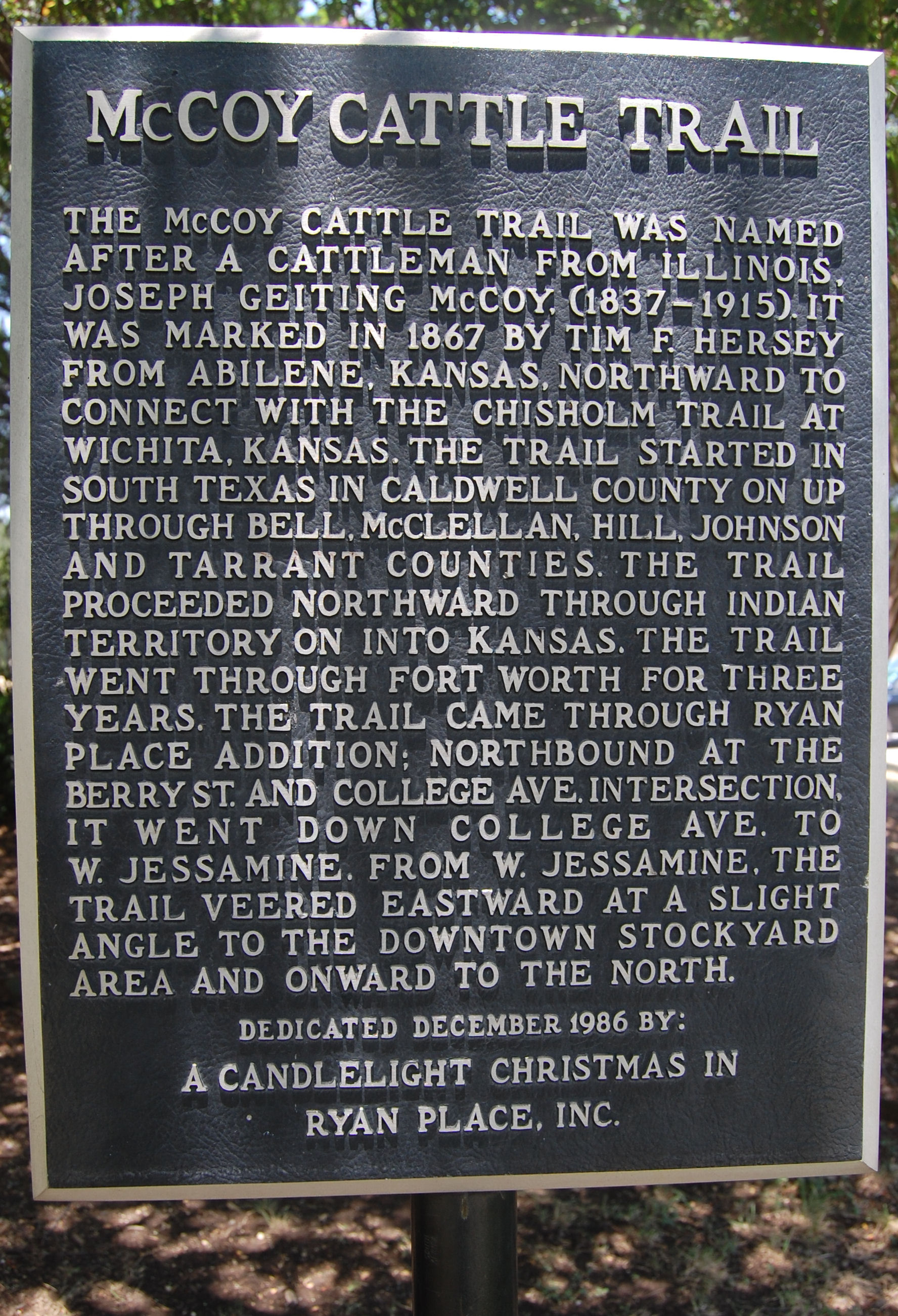 This marker in Ryan Place on Elizabeth Boulevard traces the trail from today’s intersection of Berry Street and College Avenue north to West Jessamine Street and then on to the “downtown stockyard area.”
This marker in Ryan Place on Elizabeth Boulevard traces the trail from today’s intersection of Berry Street and College Avenue north to West Jessamine Street and then on to the “downtown stockyard area.”
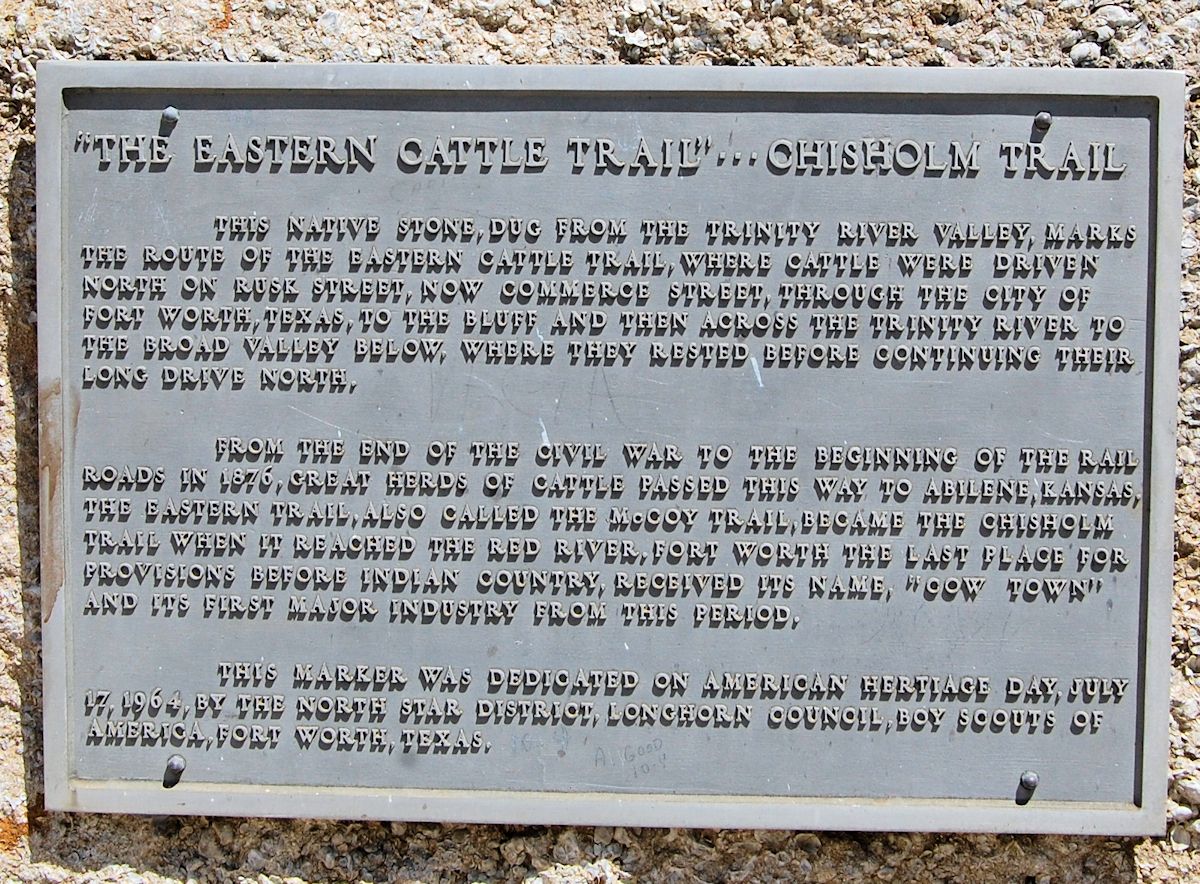 This marker is one block northeast of the Courthouse.
This marker is one block northeast of the Courthouse.
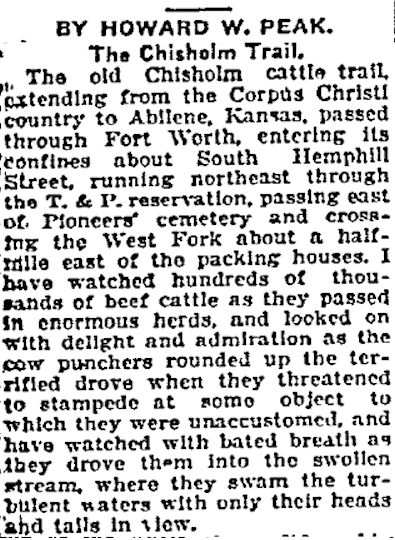 Howard Peak was in a unique position to recall early Fort Worth: He had been born in the abandoned Army fort in 1856. In 1922 he wrote that the trail passed up today’s Hemphill Street through the Texas & Pacific reservation, east of Pioneers Rest Cemetery in the Samuels Avenue neighborhood, and crossed the Trinity River a half-mile east of the packing houses. That would put the river crossing due south of . . .
Howard Peak was in a unique position to recall early Fort Worth: He had been born in the abandoned Army fort in 1856. In 1922 he wrote that the trail passed up today’s Hemphill Street through the Texas & Pacific reservation, east of Pioneers Rest Cemetery in the Samuels Avenue neighborhood, and crossed the Trinity River a half-mile east of the packing houses. That would put the river crossing due south of . . .
 Trail Drivers Park, so-named because the cattle trail passed that hillside, and herders “bedded down” the cattle nearby.
Trail Drivers Park, so-named because the cattle trail passed that hillside, and herders “bedded down” the cattle nearby.
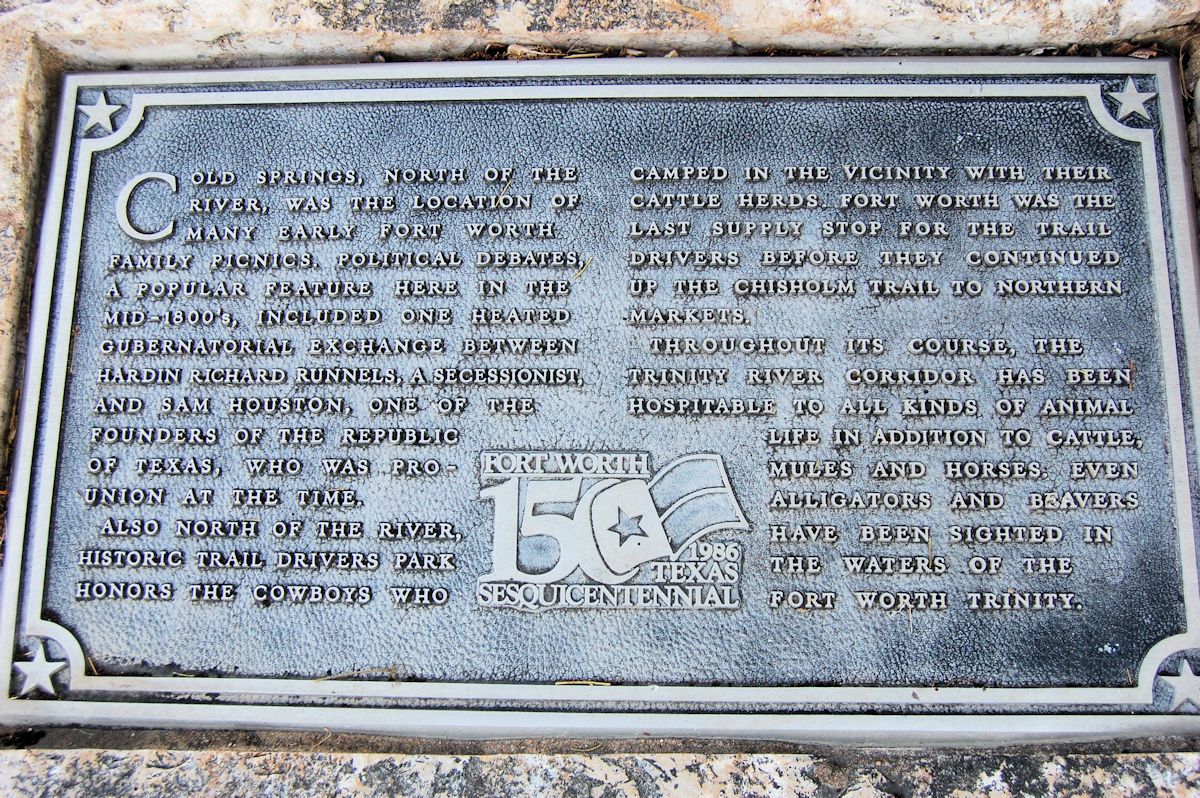 This Texas sesquicentennial marker for the Cold Springs and Trail Drivers Park says herders camped nearby.
This Texas sesquicentennial marker for the Cold Springs and Trail Drivers Park says herders camped nearby.
 In Fort Worth: A Frontier Triumph historian Julia Kathryn Garrett says the herds followed today’s Cold Springs Road to the river and forded at Daggett’s Crossing, which was east of today’s Samuels Avenue Bridge. Charles Biggers Daggett (brother of Henry Clay and Ephraim Merrell), whose plantation was located where Mount Olivet Cemetery is today, operated a ferry at the crossing until 1877, when the first county-funded bridge over the river was built near the crossing. (Illustration from Harper’s Weekly, 1867.)
In Fort Worth: A Frontier Triumph historian Julia Kathryn Garrett says the herds followed today’s Cold Springs Road to the river and forded at Daggett’s Crossing, which was east of today’s Samuels Avenue Bridge. Charles Biggers Daggett (brother of Henry Clay and Ephraim Merrell), whose plantation was located where Mount Olivet Cemetery is today, operated a ferry at the crossing until 1877, when the first county-funded bridge over the river was built near the crossing. (Illustration from Harper’s Weekly, 1867.)
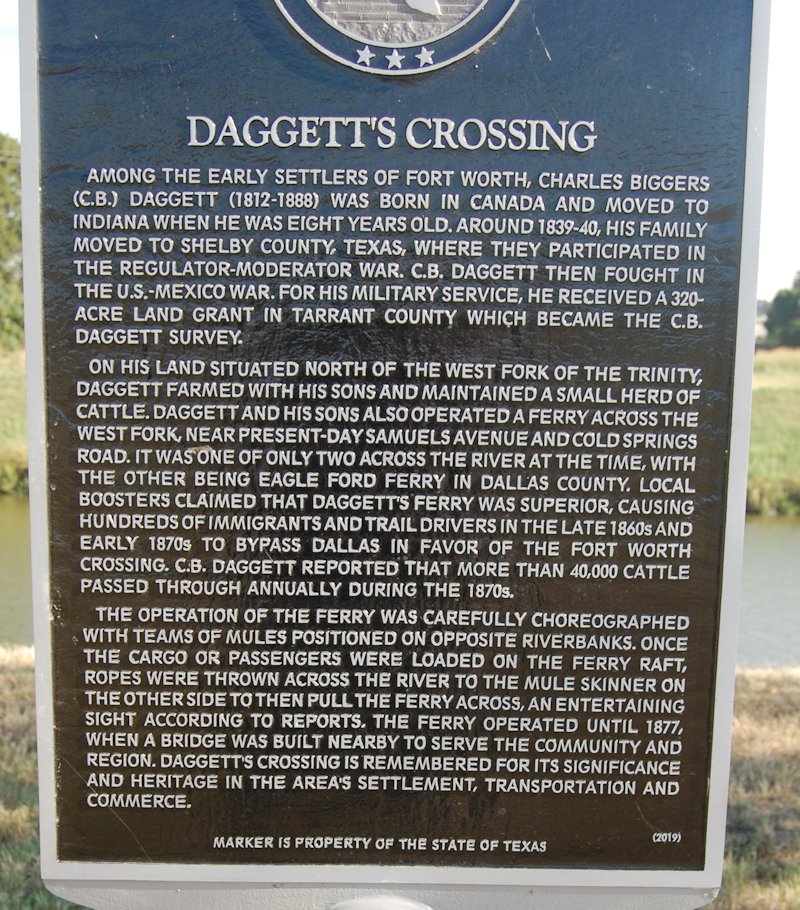 Imagine the scene—the sights and sounds and smells—as hundreds of longhorns passed through town. Rush hour on the prairie. During dry spells, dust clouds swirled as cattle hooves pulverized the sod ever finer with each passing animal. During wet spells, cattle hooves pounded soft ground into a muddy bog. Regardless of the weather, the air was full of the bellowing of cattle, the thundering of hooves, the pungency of horses and cattle, and the singing and swearing of cowboys. But for Fort Worth the sounds were a symphony of revenue, and Fort Worth would not hear anything sweeter than a cattle drive until the first locomotive whistle blew on July 19, 1876.
Imagine the scene—the sights and sounds and smells—as hundreds of longhorns passed through town. Rush hour on the prairie. During dry spells, dust clouds swirled as cattle hooves pulverized the sod ever finer with each passing animal. During wet spells, cattle hooves pounded soft ground into a muddy bog. Regardless of the weather, the air was full of the bellowing of cattle, the thundering of hooves, the pungency of horses and cattle, and the singing and swearing of cowboys. But for Fort Worth the sounds were a symphony of revenue, and Fort Worth would not hear anything sweeter than a cattle drive until the first locomotive whistle blew on July 19, 1876.
Fort Worth was the last town for supplies and R&R before the herders entered Indian Territory, so after the herders crossed the Trinity River, they camped. Leaving the herd in the custody of a skeleton crew, cowboys rode back into town to fetch supplies (flour, coffee, bacon, beans, dried fruit) at stores such as Daggett and Hatcher’s on the square. Oh, and maybe to mosey down into the Acre for a few hands of Old Maid, a bottle of sarsaparilla, and a group prayer at the gospel mission.
Or not.
The next morning, when the time came for the cowboys to “head ’em up and move ’em out,” the Acre bid them farewell with, “Y’all come back now, y’hear?” as the cowboys continued north hung over, short on cash, and soiled dove smitten.
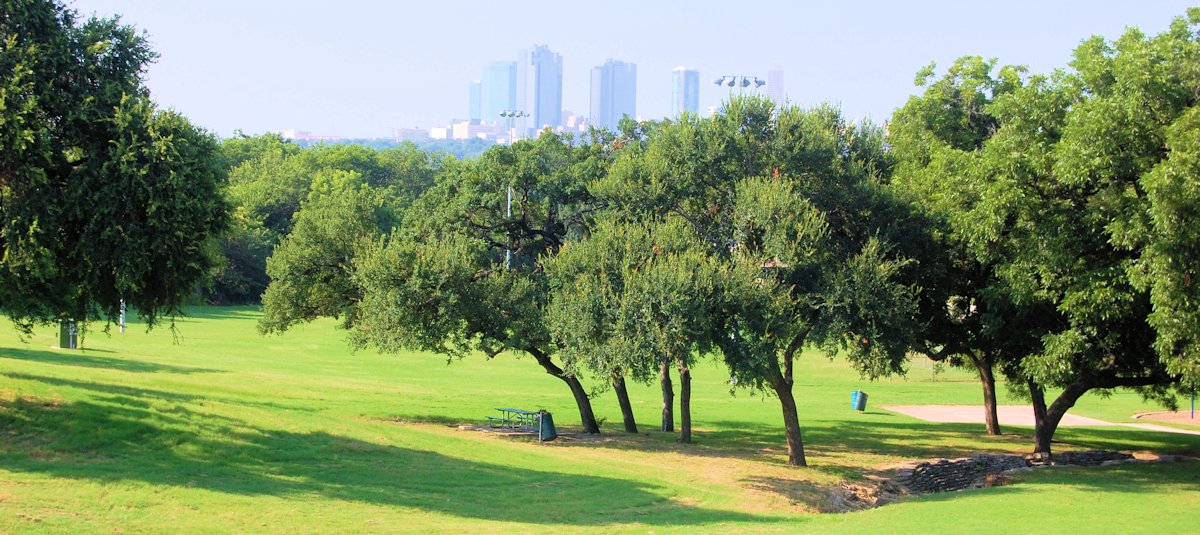 When those cowhands who had camped near Trail Drivers Park looked back at where they had been the night before, this is what they didn’t see: the skyline of a city of 800,000.
When those cowhands who had camped near Trail Drivers Park looked back at where they had been the night before, this is what they didn’t see: the skyline of a city of 800,000.
Of course, just as Fort Worth was the last stop in Texas for herders going north, Fort Worth also was the first stop for herders leaving Indian Territory on their return trip from Kansas. No doubt the herders, having time and money on their hands, were even rowdier on their return passage through Fort Worth.
The trail also became a conduit for vice as gamblers and soiled doves moved between Fort Worth and the wide-open towns of Kansas (Abilene, Wichita, Caldwell, Dodge, Ellsworth).
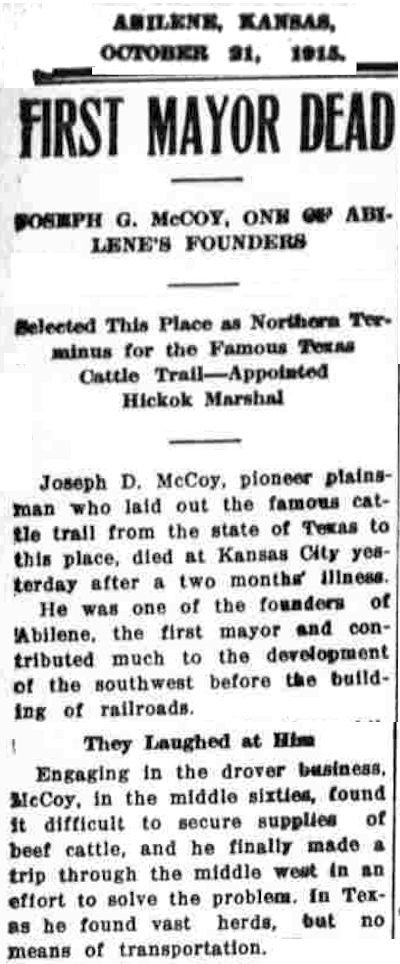 Joseph Geating McCoy died in 1915. His death made headlines from Abilene . . .
Joseph Geating McCoy died in 1915. His death made headlines from Abilene . . .
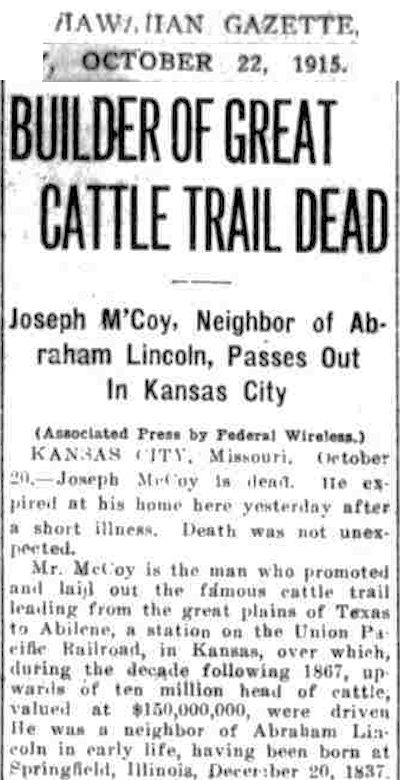 to Hawaii.
to Hawaii.
Eventually people began to refer to the entire network of trails from south Texas to the Kansas railheads as the “Chisholm Trail.” But to purists, the Chisholm Trail was only in Oklahoma and Kansas. One such purist was George Washington Saunders, a former Chisholm Trail cowboy, a founder of the Old Trail Drivers Association, and owner of a livestock commission in Fort Worth. In 1931 he wrote: “The famed Chisholm Trail . . . cannot be traced in Texas for the reason that it never existed in this State.”
Of course, the average cowboy on the trail probably didn’t care what label was applied to it as long as he survived it to bunk down with that perfumed “purty little thang” in the Acre with whom he had fallen chin over chaps in love after she called him “big boy” and insisted on cash up front.
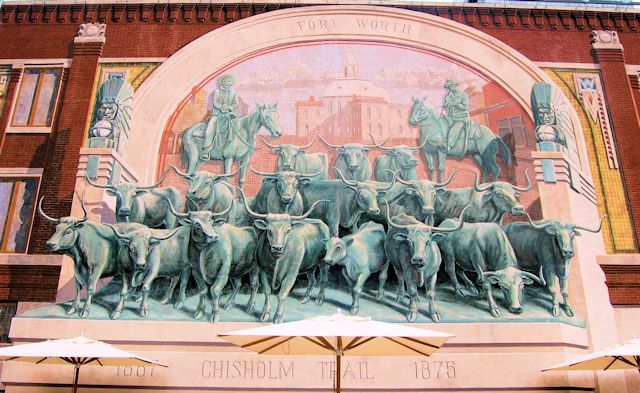 In those days of open range, cattle drives on the Chisholm Trail covered a wide swath except at river crossings. When dozens of herds were moving north simultaneously the herders had to spread out the cattle to find forage. The longhorns were allowed to graze along for ten or twelve miles a day and were not pushed except to reach the next source of water: Cattle that drank and ate their fill were less likely to stampede. A trail boss, a cook, a horse wrangler, and ten or twelve cowboys could herd 2,500 cattle. A drive from south Texas to the railhead could take three months.
In those days of open range, cattle drives on the Chisholm Trail covered a wide swath except at river crossings. When dozens of herds were moving north simultaneously the herders had to spread out the cattle to find forage. The longhorns were allowed to graze along for ten or twelve miles a day and were not pushed except to reach the next source of water: Cattle that drank and ate their fill were less likely to stampede. A trail boss, a cook, a horse wrangler, and ten or twelve cowboys could herd 2,500 cattle. A drive from south Texas to the railhead could take three months.
Most trail herders were white males, but there were Latino and African-American herders and even some women. Some women dressed as men to “pass.” One woman who defied convention was Elizabeth Johnson Williams of Austin, who had registered her own “CY” cattle brand. Some historians think she was the first woman to go up the trail with her own cattle and own brand. She accompanied her herds up the trail at least three times—in a buggy.
For cowboys on the trail the pay was low ($25 a month [$500 today]), the food was bad, the saddle was hard, the briars were sharp, the hours were long. But, hey, at least the work was dangerous. There were wild animals, rustlers, and Native Americans with a “there goes the neighborhood” attitude about white settlers.
And then there were the stampedes.
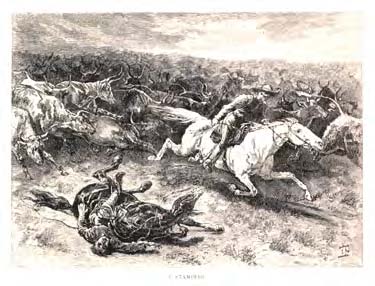 (From Harper’s Weekly, 1879.)
(From Harper’s Weekly, 1879.)
Joseph McCoy wrote: “During rainy, stormy seasons herds of cattle are apt to form the habit of stampeding every cloudy or stormy night. And although they may have long been off of the trail, held on good grazing ground, yet they are very liable to form the habit of running. It is generally the case that less than a score, often less than a half dozen of old, wild, long legged beeves, do the mischief, by getting a chronic fright, from which they never do recover; nor are they ever afterwards satisfied unless they are on the run. They would rather run than eat, any time, no matter how empty of food they may be. Stampeding becomes a mania with them, and, day or night, they seem to be looking for or studying up a pretext to set off on a forty mile jaunt. How well one stampeder gets to know every other stampeder in the herd, is astonishing, and they may be seen close together at all times, as if counseling how to raise Cain, and get off on a ‘burst of speed.’”
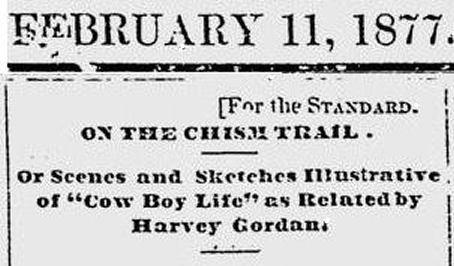 And in 1877 the Daily Fort Worth Standard printed an account by Harvey Gordan, a cowboy who had endured a stampede on the trail:
And in 1877 the Daily Fort Worth Standard printed an account by Harvey Gordan, a cowboy who had endured a stampede on the trail:
“’Twas in the spring of 1868 . . . when my father and I had a little disagreement, and he took it into his head to give me a ‘sound thrashing,’ which I richly deserved. But I could not see it in that light then, so I left my parental roof to seek my fortune elsewhere. . . . I had often wished to cow drive. . . . Soon I met a stranger who was in need of a cow hand. . . . I soon found myself mounted on a noble horse, bound for Omaha City, Nebraska. . . . On my first day’s drive all seemed in good spirits. Toward evening we came to a halt and struck camp. While some of the boys were engaged hobbling the ponies and otherwise making preparation for supper, I busied myself watching the expert sons of Mexico lassoing the cattle for the purpose of learning them to haul the ‘grub wagon.’ . . . At length came supper, then all the boys seated themselves upon the grass in a huddle around a crackling fire. Each drew from his pocket a knife, with which he fashioned a sharp stick to answer the purpose of a fork, and then all ‘dived in.’ Each one was given a tin cup into which was poured the almost boiling coffee, without either sugar or cream. . . . As I sat and munched my bread and beef and drank my coffee ‘straight,’ I thought ‘cow boy’s life’ is indeed a pleasant one. But I was soon to be undeceived, for no sooner were ‘cigarettes’ indulged in than I was placed, with two others, to stand night guard around the herd.
“My companions were both lively fellows, and we did very well ’till time for the second relief to go on duty, when I found myself free. I retired to my virtious [sic] couch upon the grass with nothing but a saddle blanket for cover. We were astir betimes next morning. . . . [O]n the third day’s drive after crossing Red River I witnessed my first stampede. . . . I beheld a dark cloud rising in the west, and at nightfall, when we stopped to encamp, it seemed to envelop the whole earth. We had barely done our lunch and cigarettes—for I had begun to smoke—when the rain commenced to fall thick and fast, and the first guard, of which I was one, was ordered to hold the cattle through the storm.
“‘Great God,’ I exclaimed. ‘In this rain?’ This was a new phase of cow boy life, and to me who had always been used to a house to shelter me from the rain and storm. It seemed horrible; nevertheless the order was given, and I had no other alternative but to obey.
“Reluctantly I mounted my horse and rode off to the herd. When I arrived the cattle were going round and round in a circle, and it required the persevering efforts of the other guards and myself to keep them together.
“The night was . . . dark, . . . and we could scarcely see anything except by the occasional flashes of lightning. . . . We had stood about half through when a gang of those infernal loafer wolves that infest those regions came yelling and howling toward us like a pack of fiends, and away went the cattle in every direction.
“I started out in pursuit of a small squad while the other boys followed suit in another direction.
“I urged my horse forward, trusting to his good eyesight rather than my own, for I could only see indistinctly a moving mass and hear the roar of hoofs ahead. . . . I gave rein to my horse, and as I sped along, I knew not where, I thought of my brothers and sisters, of how they were enjoying their nice warm beds while I dared not think what I was doing.
“But many times as I sped on and on through the almost impenetrable darkness did I ask myself the question: ‘What would I not give to be at home?’
“After what seemed an age to me, the cattle began to slack their pace and finally toned down to a walk, and then I succeeded in bringing them to a stand, and there I held them the rest of the night.
“Daylight next morning found me on Red Fork [Oklahoma], sore and stiff in every joint and limb and drenched to the skin, while just twenty miles lay between me and where I started. I rounded up and drove into camp just in time for my supper, having done without both breakfast and dinner.”
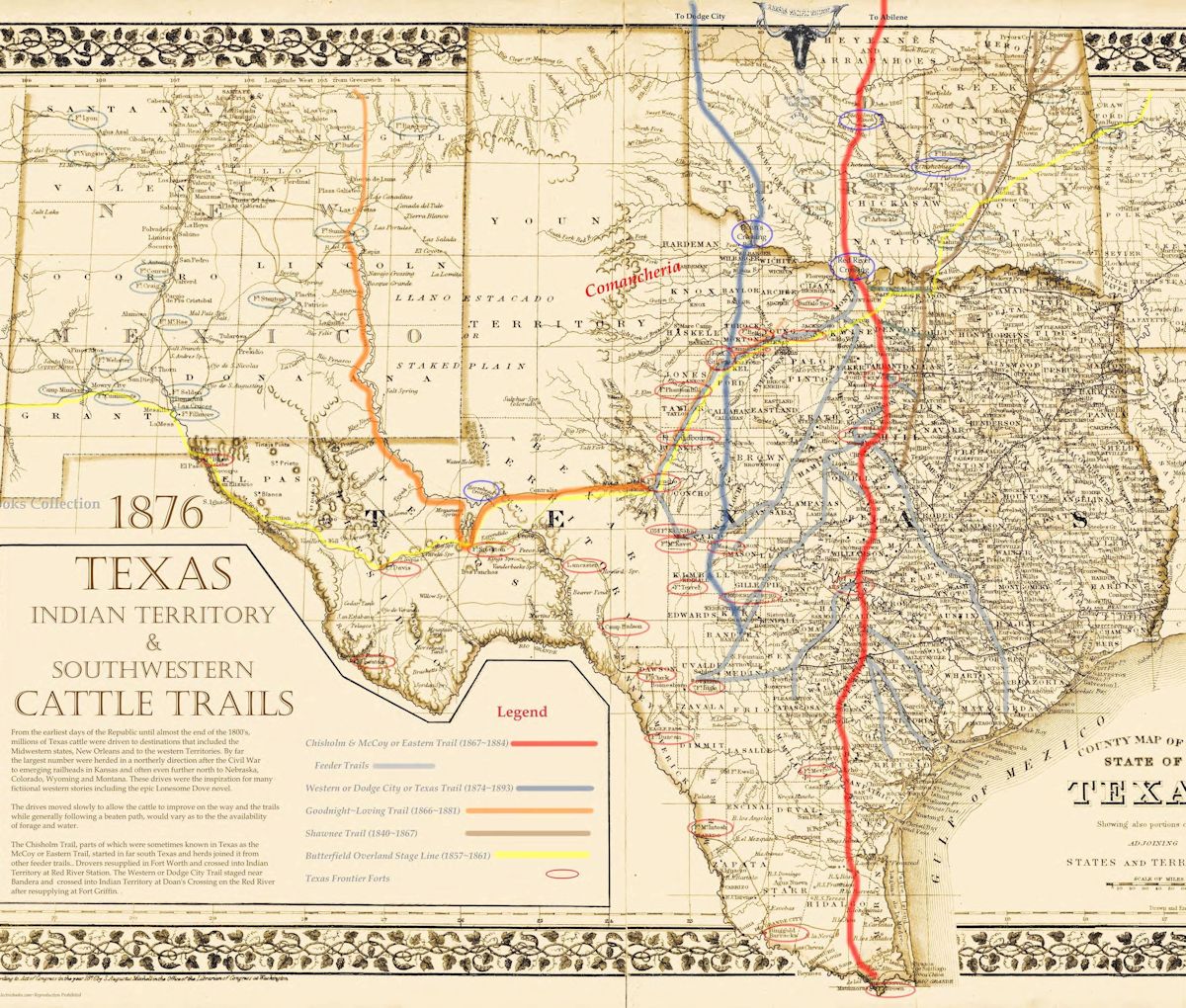 By 1876 the Chisholm Trail had new competition: The Shawnee Trail was no longer being used, but in 1874 the Western Trail had begun funneling cattle from Bandera north to Dodge City. The Western Trail ran to the west and roughly parallel to the Chisholm Trail. (From Pete Charlton’s “1000+ Lost Antique Maps of Texas & the Southwest on DVD-ROM.”)
By 1876 the Chisholm Trail had new competition: The Shawnee Trail was no longer being used, but in 1874 the Western Trail had begun funneling cattle from Bandera north to Dodge City. The Western Trail ran to the west and roughly parallel to the Chisholm Trail. (From Pete Charlton’s “1000+ Lost Antique Maps of Texas & the Southwest on DVD-ROM.”)
The final year for the Chisholm Trail as a major cattle conduit was 1884 as expansion of the railroads rendered long cattle drives less practical, as increased use of barbed-wire fence (first marketed in 1875) decreased open range, and as Kansas and Missouri enacted another quarantine law.
Today, 137 years later, along the main Chisholm Trail, the McCoy Trail, and the lesser feeder trails, cellphones chirp where once crickets chirped, sirens howl where once coyotes howled, and Broncos and Tauruses have replaced horses and steers.
But the legacy of a cattle trail named for a Scots-Cherokee who was a trader, not a cattleman, lives on in a city called “Cowtown.”
For more see Wayne Ludwig’s The Old Chisholm Trail: From Cow Path to Tourist Stop.
More on longhorns in Cowtown:
Lightning on the Draw and History on the Hoof
Cowtown in Motion: Hoof ’em, Horns
Listen to the song “Old Chisholm Trail”:
https://www.loc.gov/item/lomaxbib000139/
Posts About Cattlemen






What a great story, Mike. The pictures are most excellent. It was like being there. Following the trail would be a great adventure, like the Appalachian Trail, on steroids. I wonder if they ever came across the Lake Worth dogman or such. Back then anything could have been out there.
Thanks, Earl. I learned a lot. What a life Jesse Chisholm led, a bit like that of Sam Houston. (Some say the two men were related by marriage.) We can’t imagine what it was like to live daily life and to travel back then. All of life was “roughing it.”
I so look forward to your ‘history lessons’! Each one is even better than the last! Thank you for your passion and dedication for the history of our great Cowtown and State!
Love and Blessings,
~ Judy ~
Thank you so much for your support, Judy.